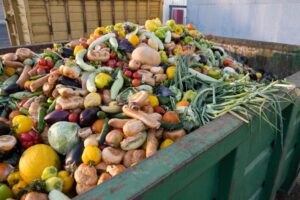Ever get to the end of the week faced with a fridge full of rotting produce and gone off meat because plans to cook up a storm got sidetracked by a last minute dinner invitation, or a deadline that kept you working at the office?
You’re not alone.
In the US, 40% of food that’s produced is wasted, and 42% of this happens at home. Fruits and vegetables are the most wasted category of food with 52% going to waste, followed by seafood (50%), grains-based food such as bread (38%), meat (22%), and milk (20%).
While most people know that wasting food is bad, they are unaware of the consequences of this food loss, according to JoAnne Berkenkamp, senior advocate, Food & Agriculture Program, National Resources Defense Council.
Speaking to the National Press Foundation’s recent food and agriculture fellowship, Berkenkamp put some of the consequences of food waste into compelling and relatable terms.
If food waste was a running shower…
Agriculture is a major user of water resources globally, accounting for about 80% of ground and surface water use in the US. Berkenkamp said that 21% of fresh water is used to grow food that doesn’t get eaten. To put into even more shocking context, if you waste four ounces of chocolate, it’s the same as leaving a shower running for 90 minutes, or worse still; wasting one pound of beef represents over six hours of shower time.
If food waste was a country…
If food waste was a country, it would be the third largest emitter of greenhouse gases in the world after China and the US. Food waste accounts for the same amount of greenhouse gas emissions as 37 million cars; that’s 1-in-7 cars in the US. Agriculture is an energy-intensive business all along the supply chain, so whenever food is wasted, it results in the unnecessary use of fuel in the manufacture of inputs such as fertilizers, the transport of food, food processing among other activities.
If landfills had no food waste…
Local governments are starting to wake up to the issue of food waste because 95 percent of wasted food goes to landfill or is incinerated in the US, as the single largest category of waste in landfill. Landfills are becoming an increasing environmental hazard the world over because they release toxic materials — leachate — into the soil and contaminate the groundwater. Large quantities of decomposing food also release large amounts of methane in another contributor to greenhouse gas emissions, and a hazard because methane is flammable.
If food waste was an economy…
Food waste costs over $100 billion a year in the US, which is particularly stark when more than 42 million Americans are food insecure and lacking a stable, reliable supply of food; that’s more than the population of Canada. The cost of American food waste is roughly equivalent to the gross domestic product of a small Caribbean Island.
The macro statistics on food waste can sometimes be hard to relate to. But as Berkenkamp proved, change the metrics to more tangible concepts and the problem quickly comes into focus.
Luckily there is a growing number of startup companies trying to combat waste at various points in the chain; ReFED, a non-profit coalition dedicated to solving the problem in the US, counts at least 64 startups in its Food Waste Innovator Database . But it’s still a small portion of the overall agri-food tech ecosystem, and more innovation and investment is needed.















Sponsored
International Fresh Produce Association launches year 3 of its produce accelerator